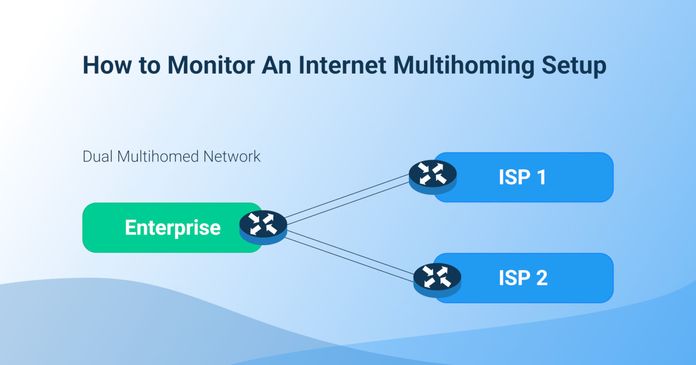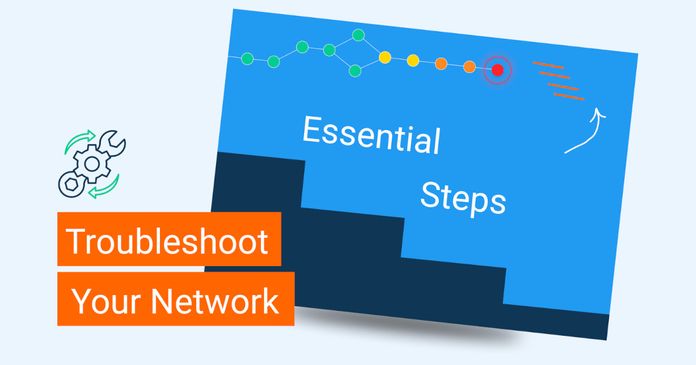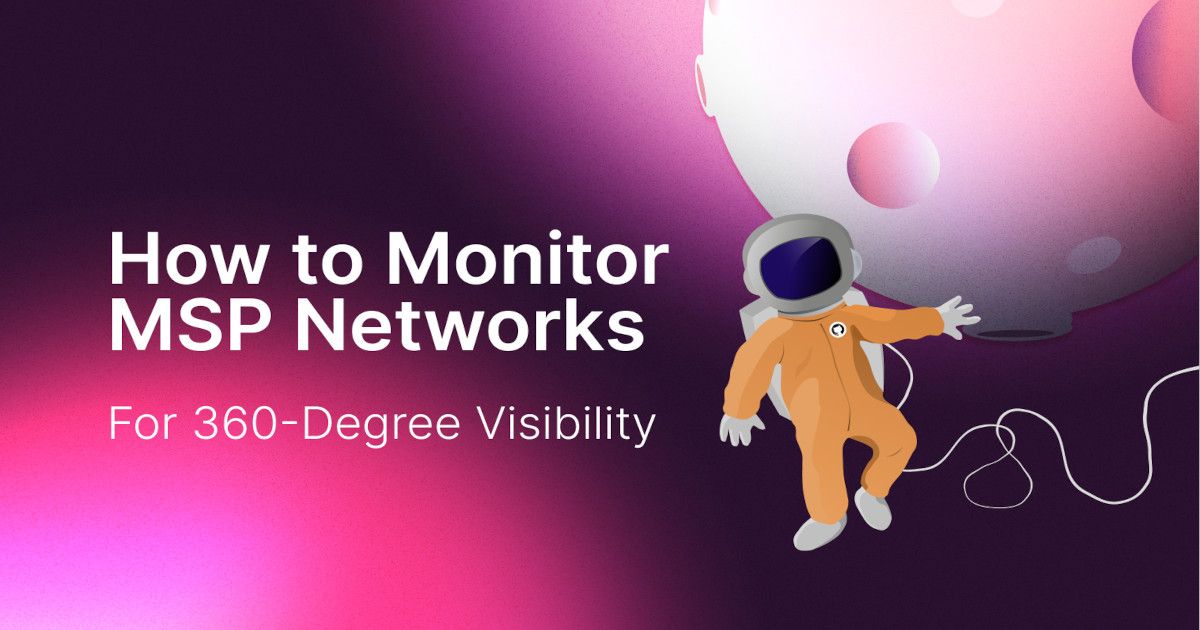Table of Contents
Table of Contents
In today's era dominated by digital connectivity, the pivotal role of Internet Service Providers (ISPs) in shaping our online experiences and facilitating business operations cannot be overstated. The quality of Internet services has emerged as a critical factor, directly impacting both individuals' daily activities and the operational efficiency of companies.
Thus, understanding how to monitor an ISP network in the right and most efficient way is a cornerstone for every network admin seeking comprehensive visibility and a profound understanding of network dynamics. It goes beyond merely observing, it's about gaining insights into the cause and effect of various events within the network.
ISP networks are the backbone of the Internet, connecting our homes and businesses to the world of information through a sophisticated web of technology. In simpler terms, these networks encompass the infrastructure and systems utilized by Internet Providers to link users to the vast world of the Internet.
Breaking it down further, here's what makes up an ISP network:
- Infrastructure: ISPs boast a network infrastructure featuring a mix of wired (think fibre optic cables, coaxial cables) and wireless technologies (like satellite, Wi-Fi, and cellular). This infrastructure is meticulously crafted to ferry data from the ISP's hub to individual customers.
- Data Centers: Picture data centers as the nerve centers of ISPs. Here, servers and networking equipment reside, hosting the plethora of content, applications, and services customers access online. These centers also handle critical tasks like routing, traffic management, and storage.
- Peering and Transit: ISPs engage in a sophisticated dance with one another through peering and transit agreements. Peering involves the direct exchange of traffic between ISPs without financial transactions. Transit, on the other hand, sees ISPs paying larger providers for a gateway to the broader Internet.
- Routing and Switching: To keep the data flowing smoothly, ISP networks employ routers and switches. Routers decide the optimal path for data travelling between networks, while switches facilitate the movement of data within a network.
- Customer Premises Equipment (CPE): ISPs equip customers with the necessary tools to dive into the online realm. This could include modems, routers, and other devices that empower users to establish a connection and tap into the ISP's network.
- Service Plans: ISPs roll out an array of service plans catering to diverse customer needs. These plans differ in terms of speed, data limits, and additional services. DSL, cable, fibre-optic, and wireless (like Wi-Fi and cellular) are common flavours of Internet connections ISPs serve up.
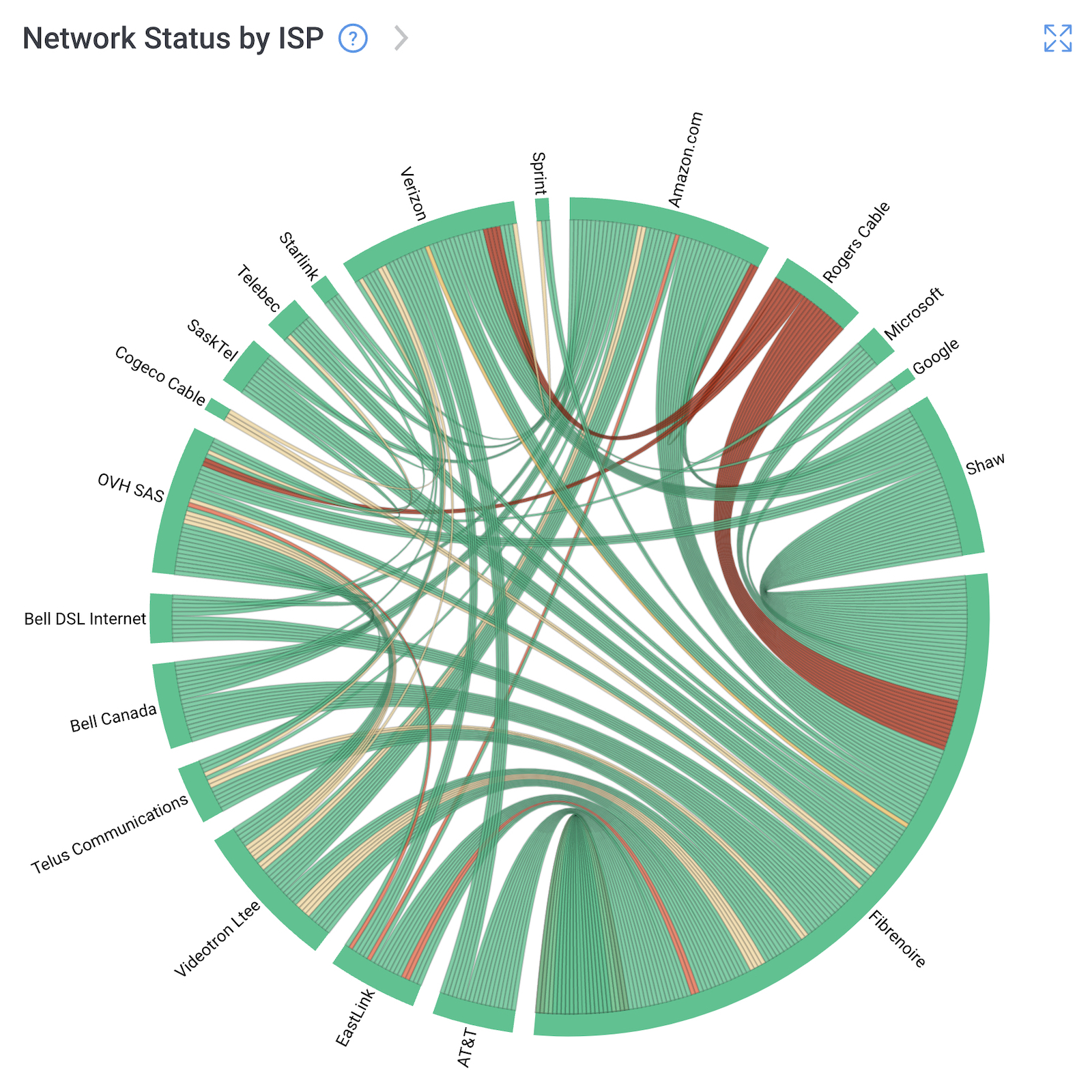

ISPs typically present a variety of packages with different broadband options tailored to meet the diverse needs of users. These packages are designed with considerations such as connection speed, the required number of email addresses, allocated web space, etc. The goal is to offer users flexibility and options aligned with their specific preferences and usage requirements.
Many Internet providers deliver a standard set of services and features, encompassing:
- Internet Access
- Email Access
- Domain Name Registration
- Web Hosting
- Co-location (or data center services)
- VoIP Services
- Cybersecurity Services (MSSPs)
- Streaming and other Value-Added Services
ISPs employ various technologies to facilitate customer connections to their network. The most common two types of Internet connection include:
Fibre optic Internet, commonly referred to as "fibre," represents a broadband connection that transmits data using light signals through thin strands of glass or plastic, known as fibre optic cables. Renowned for its high-speed transmission at the speed of light, fibre stands out as one of the fastest Internet options.
While fibre availability has rapidly expanded in urban and suburban areas, rural regions may encounter challenges in accessing fibre connections due to infrastructure development costs. A potential drawback lies in the installation cost, which can be higher than other connection types.
Pros:
- Ultra-fast speeds, often reaching gigabit levels.
- Reliable connection with minimal interference.
- Capable of supporting multiple devices and high-demand applications.
- Less susceptible to distance-related degradation compared to copper lines.
- Facilitates efficient network monitoring for enhanced performance and issue detection.
Cons:
- Not as widely available in all regions, especially rural areas.
- Higher initial installation costs.
- Requires a dedicated line, possibly leading to longer setup times.
- Network monitoring complexity may vary, potentially requiring specialized expertise for optimal utilization.
Learn how to monitor and identify network and Internet outages, like the nationwide Rogers outage, to stay updated on your ISP network status.
Learn more

Fixed Wireless Internet delivers broadband connectivity by transmitting signals between a stationary antenna at the user's location and a central base station. This technology is great for rural or remote areas where traditional wired broadband services like DSL or cable are scarce.
Unlike 5G Home Internet, Fixed Wireless relies on different infrastructure and frequencies. Installations typically involve an external antenna mounted to the home, requiring a clear line-of-sight to the service provider's tower for the strongest and most stable connection.
Pros:
- Provides Internet access in regions with limited or no alternatives.
- Offers reliable speeds, especially with a clear line-of-sight.
- Faster and more stable than satellite Internet.
- Doesn't depend on ground-based infrastructure like DSL or cable.
- Great performance with proper ISP network monitoring software in place.
Cons:
- Performance may vary based on distance from the tower and potential obstructions.
- Weather conditions can occasionally impact the connection.
- Speeds, while decent, might not match those of fibre or advanced 5G installations.
- Professional installation is often required, potentially incurring additional costs.
- Hard to identify the issue (without tailored ISP network monitoring tools) when the network goes down.
Regardless of the type of ISP network you operate, comprehending the specifics of your infrastructure is the first step toward effective network management. Recognizing the intricacies of your broadband packages, services, and the technologies employed for customer connections lays the foundation for tailored ISP performance monitoring.
Discover the benefits of ISP Network Monitoring software with Obkio which is tailored for diverse ISP network infrastructures. With our user-friendly design, you'll be up and running in no time.
You can easily identify and fix problems, get real-time insights into ISP network performance, and provide your business clients with the tools they need to take charge of their own network troubleshooting with Obkio. Stop pointing fingers and bring in a new era of cooperation and problem-solving.

Join the ranks of ISP business owners who rely on our cutting-edge platform to improve customer connections, increase operational effectiveness, and cement their status as innovators in technology.
Take advantage of a free trial now to learn more about ISP Network Monitoring's future.

ISP network monitoring involves the systematic observation and management of the network infrastructure's performance, availability, and security. This proactive approach empowers Internet providers with real-time insights, allowing them to gauge and enhance the optimal performance of their network.
Crucially, it facilitates the definition of service quality from an end-user perspective, ensuring a seamless Internet experience. Robust ISP network performance monitoring is imperative for delivering a reliable and high-quality Internet service to your customers while safeguarding the security and integrity of your network infrastructure.
To accomplish this, businesses employ specialized ISP network monitoring tools, which offer a comprehensive understanding of the network’s health. This includes:
Continuous Device Assessment: Ensuring the optimal functionality of network devices such as routers, switches, servers, and endpoints.
Bandwidth Utilization Tracking: Identifying congestion issues or potential bottlenecks affecting network performance by monitoring bandwidth utilization.
Network Traffic Examination: Detecting irregular patterns or potential security breaches that demand immediate attention by thoroughly examining network traffic.
Application Performance Evaluation: Assessing the responsiveness and effectiveness of applications on the network to prioritize an optimal user experience.
Security Threat Monitoring: Active surveillance for unauthorized access attempts, malware, viruses, and other security threats to maintain network integrity.
Uptime Monitoring: Continuous tracking of network availability (uptime) to minimize disruptions (downtime) and ensure a reliable service.
Alerts and Notifications Implementation: Setting up alerts triggered by predefined thresholds or anomalies to respond promptly to emerging issues.
ISP networks are complex infrastructures, supporting a variety of network locations, devices and services. ISP Network monitoring allows them to guarantee the peak performance of all these dependencies.
ISP Network Performance Monitoring acts as a watchdog, closely examining network parameters and pointing out any deviations from the norm. ISPs can prevent problems before they become more serious by regularly monitoring and evaluating their internal networks, which serve as the foundation for dependable Internet services.
The emphasis goes beyond the internal network to provide a smooth interaction between the Internet provider and its clients. As the bridge, ISP Network Monitoring provides total visibility to guarantee that the connection is not only made but also continuously optimized for a continuous, excellent user experience.
In essence, mastering the art of ISP performance monitoring is a dual triumph – empowering network admins with the tools to maintain a resilient infrastructure and providing business owners with the means to build a reputation for reliability. It's a symbiotic relationship where technical proficiency meets business strategy, creating a path to sustained success in the competitive landscape of the telecommunications industry.
Navigating the intricacies of network issues often places Internet providers in the crossfire of customer complaints, prompting a complex exchange of blame and responsibility. Monitor ISP performance to address this challenge effectively and enjoy the following benefits:
Proactive Issue Detection: ISP network monitoring enables the early identification of potential network problems, ranging from hardware glitches to software bugs and security breaches. This proactive approach prevents downtime and disruptions, safeguarding crucial business activities from interruptions.
Elevating ISP Network Reliability: Swift detection and resolution of issues by ISP network monitoring significantly reduce network downtime. This, in turn, enhances customer satisfaction, minimizes revenue loss, and boosts productivity, establishing ISPs as reliable partners committed to seamless service delivery.
ISP Network Efficiency Optimization: Through meticulous analysis of traffic patterns and network performance, ISPs can identify bottlenecks, allocate resources more efficiently, and ensure the smooth operation of services and applications. This optimization guarantees clients a superior user experience.
Tailored Network Monitoring for ISP: Enjoy the flexibility to customize monitoring plans to meet the specific requirements of each customer. This personalized approach supports a more individualized and efficient monitoring system aligned with corporate goals and requirements.
Efficient Resource Allocation: ISP performance monitoring tracks bandwidth, server space, and storage usage, facilitating effective resource allocation and scalable growth at a reasonable cost.
Instant Network Alerts: ISP Network Monitoring tools promptly send alerts and messages when predefined thresholds are exceeded or anomalies are detected. This capability ensures timely action and effective problem-solving.
Informed Decision-Making: The insights gained from ISP performance monitoring serve as invaluable resources guiding tactical decisions related to network enhancements, improvements, and IT expenditures.
Ensuring Service Compliance: ISP Network Monitoring software aids in maintaining compliance with industry norms, ensuring that data handling protocols and security measures align with sector-specific laws and standards.
Comprehensive Reporting: ISPs can provide customers with detailed dashboards and reports highlighting security, network performance, and other crucial data. This transparency strengthens the partnership between ISPs and clients, instilling confidence in the relationship.
Empowering Customers: ISP Network Monitoring software empowers customers to assertively demonstrate network issues. Armed with tangible data and real-time insights, customers can confidently present their cases, prompting ISPs to take prompt and serious action. This not only fosters a relationship built on trust and responsiveness but also expedites issue resolution.
Fostering Growth Through Referrals: In a competitive landscape, where positive word of mouth becomes a driver of growth, satisfied customers are not just retained, they become advocates for your business. ISP performance monitoring is, therefore, not only a technical necessity but a strategic asset for ISP business owners. It forms the bedrock for cultivating a satisfied customer base that willingly promotes the services to friends, family, and associates. In an age where referrals and recommendations carry substantial weight, a well-monitored network becomes a catalyst for organic business growth.
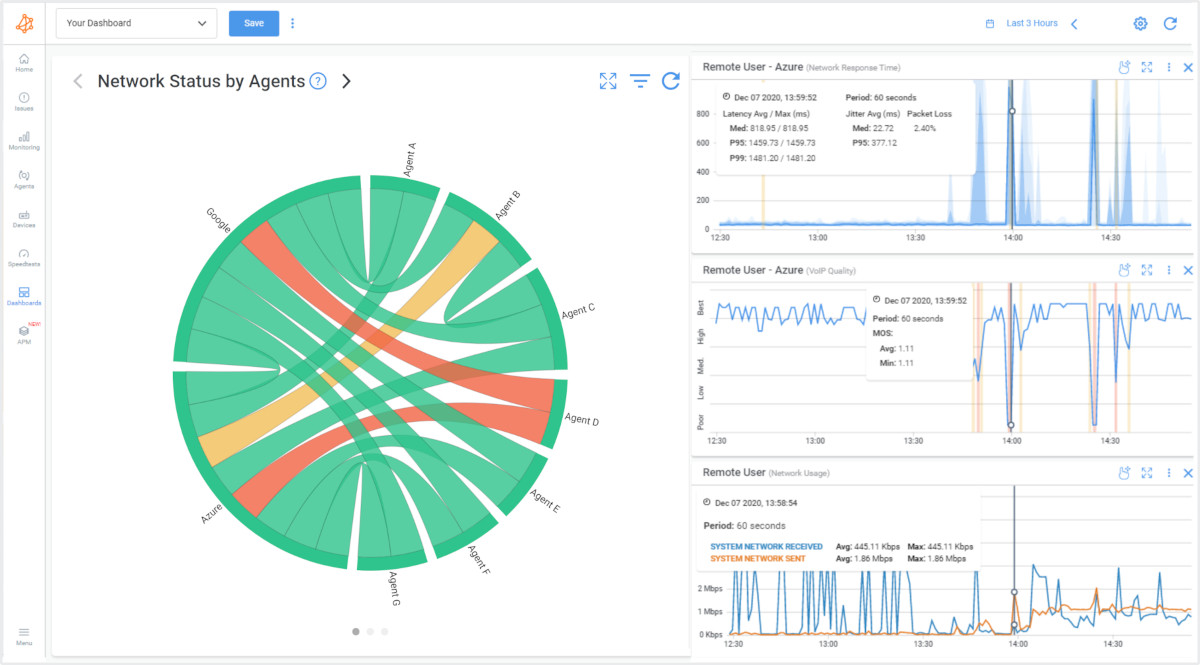
Regardless of the origin of the issue, customers will always look to you first to solve it. That’s where the game of message ping-pong begins. It's a continual exchange of hundreds of support tickets between customers and their Internet provider. All fingers point your way, seeking answers and resolution, but the twists and turns of the network create a challenging maze.
Before delving further, let's take a look into the reality of providing Internet services. Managing business and residential customers involves navigating distinct needs and preferences. It's not just about scale, it's about immersing yourself in the intricate configurations of business networks, demanding ISPs to elevate their game in identifying and solving issues before impact.
For businesses, downtime isn't merely an inconvenience, it's a financial drain. Just one hour of connectivity loss can cost over $100,000 for 98% of companies dependent on a functioning link for sales. And the consequences of an unstable link extend beyond inconvenience – your ISP reputation takes a hit.
Disrupting business network reliability goes beyond irritating customers, it triggers a full-blown crisis. A chorus of complaints, high churn rates, and disappearing revenue become the new reality. In the game of connectivity, one's reputation is all.
Taking care of business Internet services is more than just checking boxes, they also involve protecting their operations, reputation, and the stability of your own organization. Accuracy, dependability, and quick problem-solving are not simply wise choices in this fast-paced environment; they are the only choices that will lead to success.
On the flip side, residential users, often lacking technical expertise, grapple with Internet issues without a clear understanding of the original cause.
Lifemote across across twelve ISPs in five countries, engaging around 8.3 million users, sheds light on the prevalent challenges faced by customers, particularly concerning in-home Wi-Fi. Let's analyze them:
1. Coverage Issues
The most common Wi-Fi woe, affecting about one-third of households, emphasizes the need for expansive and reliable coverage to ensure uninterrupted Wi-Fi experiences.
2. 2.4 GHz Congestion
The second most common issue impacting Quality of Experience (QoE) for one in every five households. Tackling congestion becomes crucial for optimizing network performance and ensuring consistent connectivity.
3. Client-Related Issues
Although less common, client-related problems, including legacy Wi-Fi technology and data-hungry clients causing bottlenecks, should not be overlooked. Addressing these issues is key to enhancing the overall Wi-Fi experience.
These issues, coupled with customers' limited technical expertise, lead to prolonged support calls, escalating operational costs. Frequent dispatch of technicians for on-site Wi-Fi support calls contributes to extended issue resolution times, straining customer service and increasing churn rates.
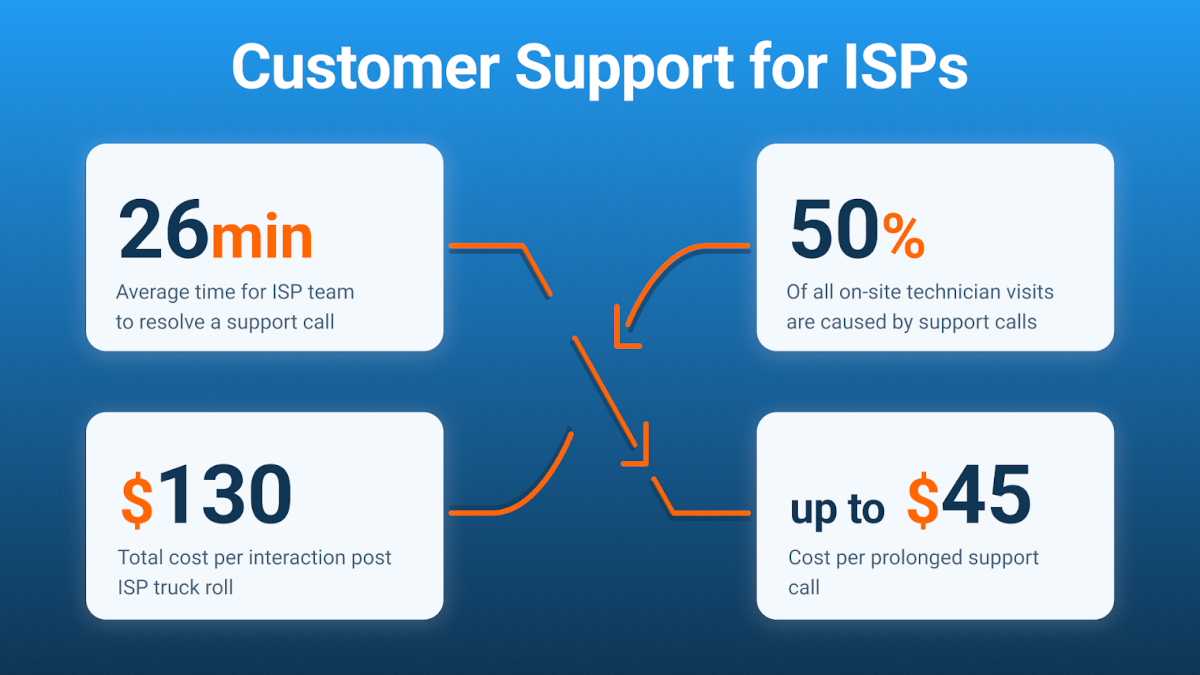
With that said the inefficiency in swiftly resolving Wi-Fi issues not only adversely affects the customer experience but also imposes a significant financial pitfall on ISPs. It creates a cycle impacting both operational efficiency and customer satisfaction, highlighting the crucial role of streamlined ISP Network Monitoring Software in breaking free from this loop.
Analysys Mason explores the transformative impact of remote network monitoring and automation on support services for residential consumers. Drawing insights from interviews with ISPs serving an initial subscriber base of 3 million users across emerging and developed markets, spanning three years, the research showcases the potential of these solutions to bring substantial cost efficiencies.
Integrating automation in customer support and ISP network monitoring emerges as a game-changer, offering a remarkable 20% reduction in costs in the long term. For example, this journey includes deploying automated remote device monitoring tools and proactive troubleshooting for Tier 1 customer care representatives.
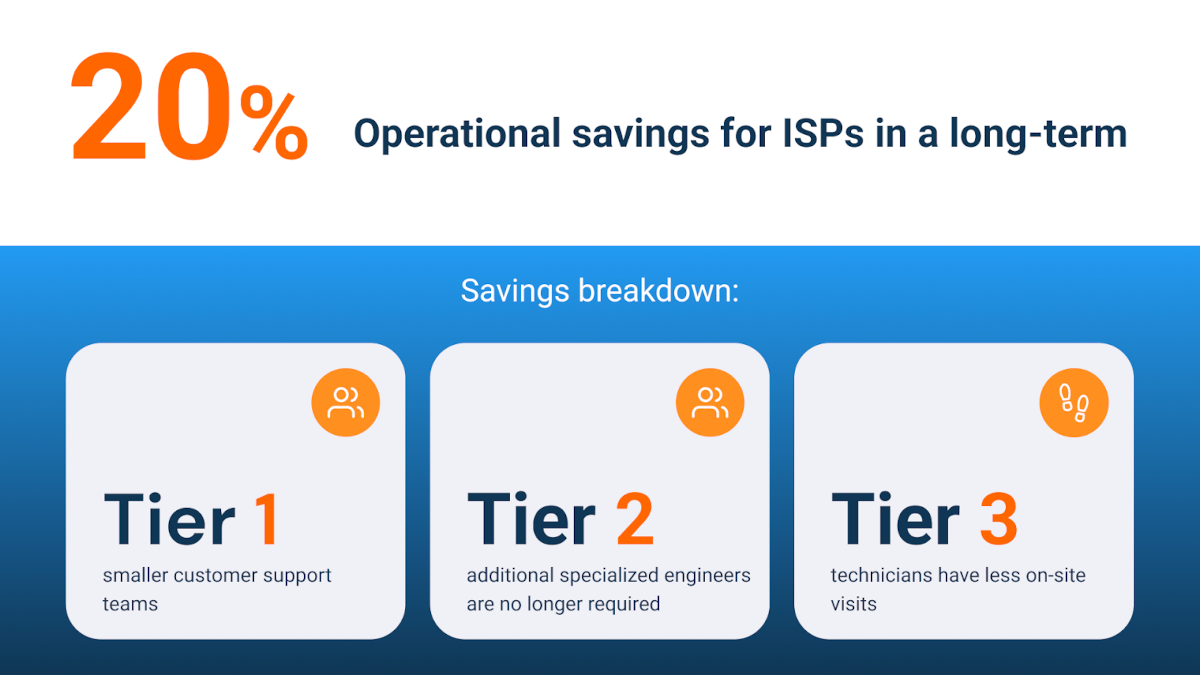
This strategic approach not only allows local ISPs to deliver high-quality services at affordable prices, attracting a broader customer base and ensuring long-term business success but also positions them to differentiate themselves from larger telcos. Moreover, the cost savings from these automation strategies empower ISPs to redirect resources to pivotal business activities, such as robust marketing initiatives.
As a result, the use of ISP Network Monitoring Software acts as a catalyst to transform the home broadband market and promote productivity, competitiveness, and long-term business success for Internet providers.
Although many local providers first choose to save money by using several open-source ISP Network Monitoring tools, the cost savings are not worth it in most cases. These solutions have poor ISP performance monitoring capabilities due to their restricted features, complicated workflows, and limited integrations. This creates a series of problems since it directly affects customer service and ISP network performance.
Given these difficulties, it is vital to select a reliable and integrated solution that analyzes network performance in addition to offering thorough visibility into ISP network monitoring. This option ensures that your ISP network functions flawlessly and provides both business and residential clients with an exceptional experience by streamlining workflows for effective issue resolution.
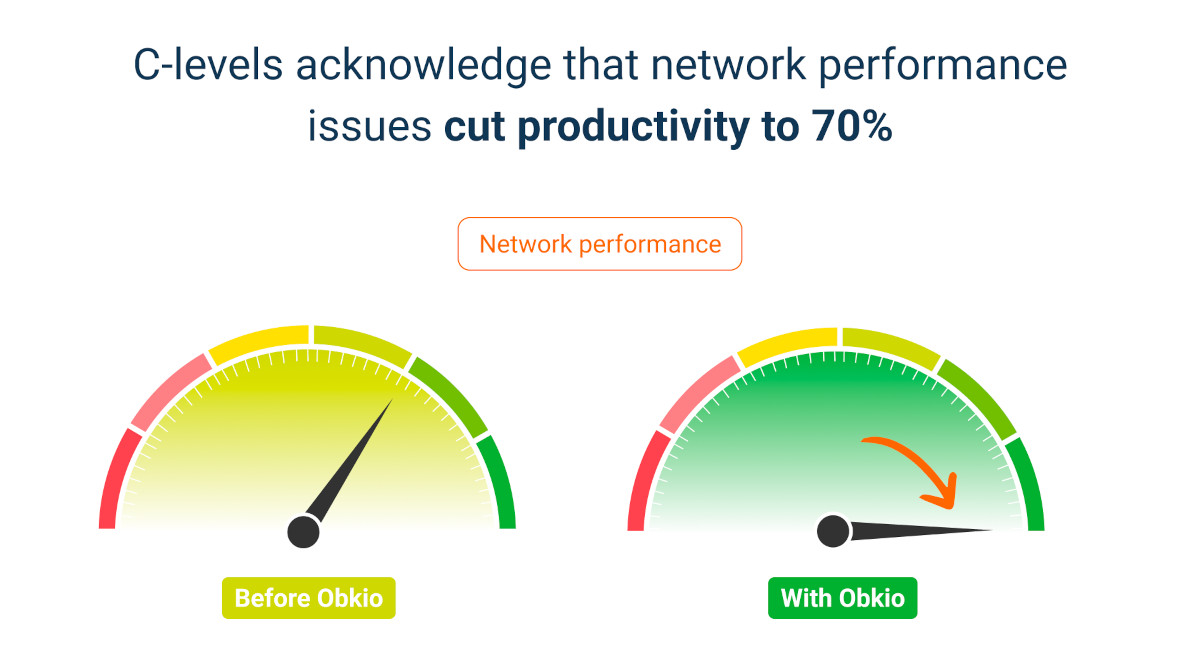
Easily navigate through the turns and loops of network difficulties by joining the increasing number of fellow ISP owners who have chosen Obkio's ISP Network Performance Monitoring tool.
Once you start to monitor ISP performance, everything becomes clear, everything runs well, and everyone gets to enjoy a drama-free Internet experience.
- 14-day free trial of all premium features
- Monitor performance in all key network locations
- Measure real-time network metrics
- Identify and troubleshoot live network problems
With just 10 minutes to spare for deployment, Obkio lets you immediately begin tracking ISP network performance!

There are unique issues in network performance optimization for Internet service providers. In this complex environment, customized monitoring solutions are necessary to guarantee the smooth running of internal networks and to sustain an unbroken connection with clients. The ISP Network Monitoring Solution from Obkio shines like a lighthouse, easily and quickly locating and fixing network problems.
ISPs can now monitor their internal network performance as well as the performance between their network and clients thanks to Obkio's end-to-end Network Monitoring SaaS service.
Through distributed Monitoring Agents and synthetic traffic, ISPs can obtain real-time insights into the performance of each individual customer network as well as their network.
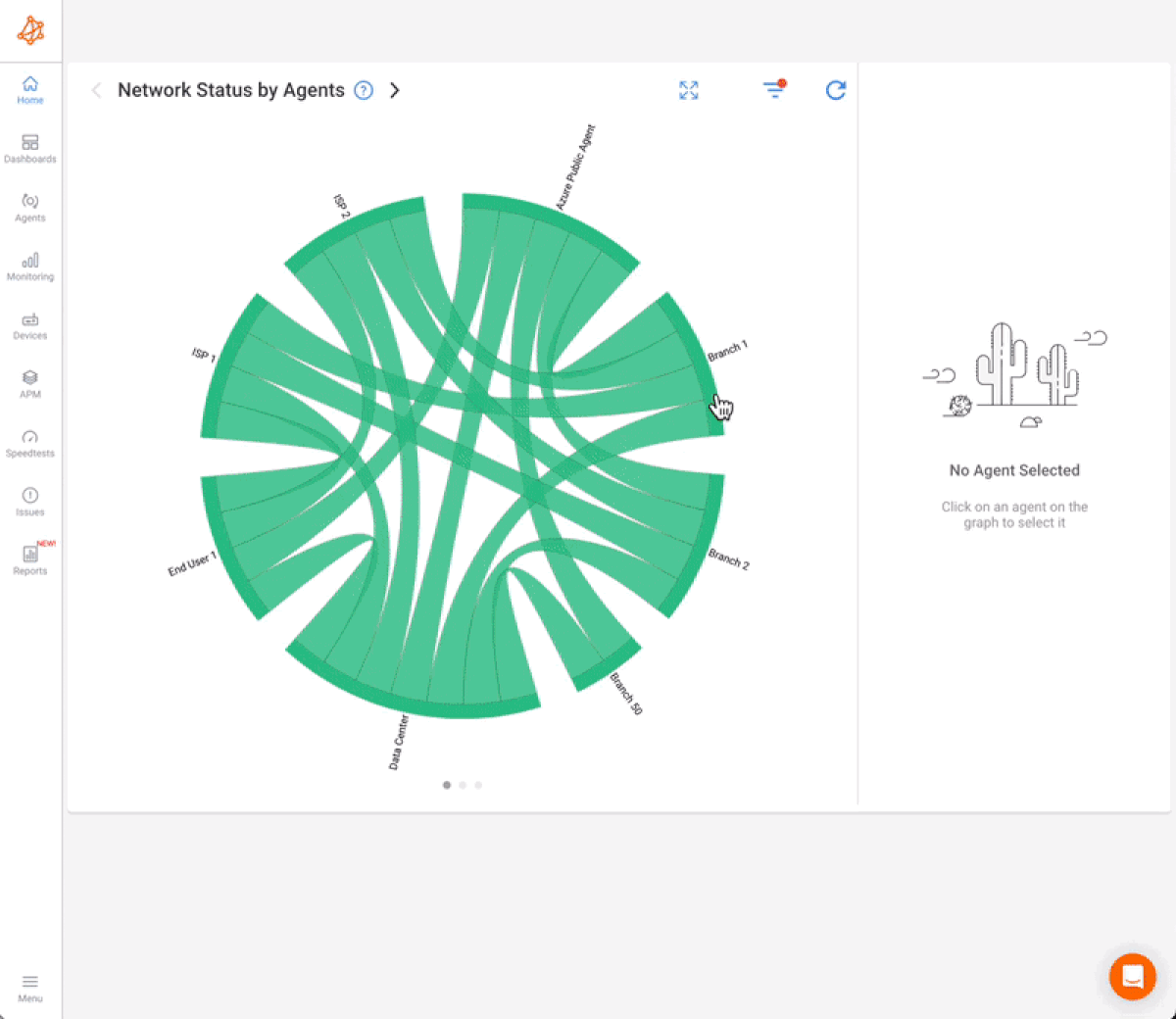
Say goodbye to guesswork and finger-pointing and welcome to the golden age of productive problem-solving with Obkio. Easily identify and fix problems, giving customers the ability to handle their own network troubleshooting.
ISP Network Monitoring Advantages:
- Better User Relations: Promote customer trust by providing clear, up-to-date insight into each client network as well as your ISP network.
- Proactive Problem Solving: Keep an eye on ISP performance and take care of network problems before they affect customers to avoid interruptions and downtime.
- Personalized Insights: Assert your dedication to your client's success by tailoring monitoring reports to their particular requirements.
- Reduce Manual Involvement: Maximize resource allocation, and simplify network management to achieve more while doing less.
- Market Attraction: Showcase yourself as a forward-thinking ISP that prioritizes the user experience over technology and keeps up with the latest developments.

Network and Internet performance are continuously monitored throughout an ISP's network by Monitoring Agents, specialized software embedded in Obkio's ISP network performance monitoring system. Positioned effectively, these Agents detect network issues across platforms, apps, and the Internet, offering a wealth of information, particularly about client networks without affecting real user traffic.
These agents monitor ISP performance throughout branch offices, corporate headquarters, data centers, clouds, and the Internet, simulating traffic exchanges every 500 ms. ISPs overseeing multiple network locations will find this distributed network monitoring technique ideal since it offers a wealth of knowledge, especially when it comes to client networks.
Local agents (Windows, MacOS, Linux, and Hardware) are installed in key network locations, such as data centers, branch offices, and remote locations, in order to monitor performance.
Public monitoring agents are those that are set up on service provider networks like AWS, Google, and Azure. They allow you to examine how any branch performs externally to the Internet (without having to go through the central office).
Furthermore, some ISPs choose to host their own Public Monitoring Agents, allowing their clients to monitor network performance all the way up to the ISP network infrastructure using pre-deployed Agents.
For ISPs to take full advantage of Obkio's Network Monitoring solution, they first deploy Monitoring Agents in their local network architecture.
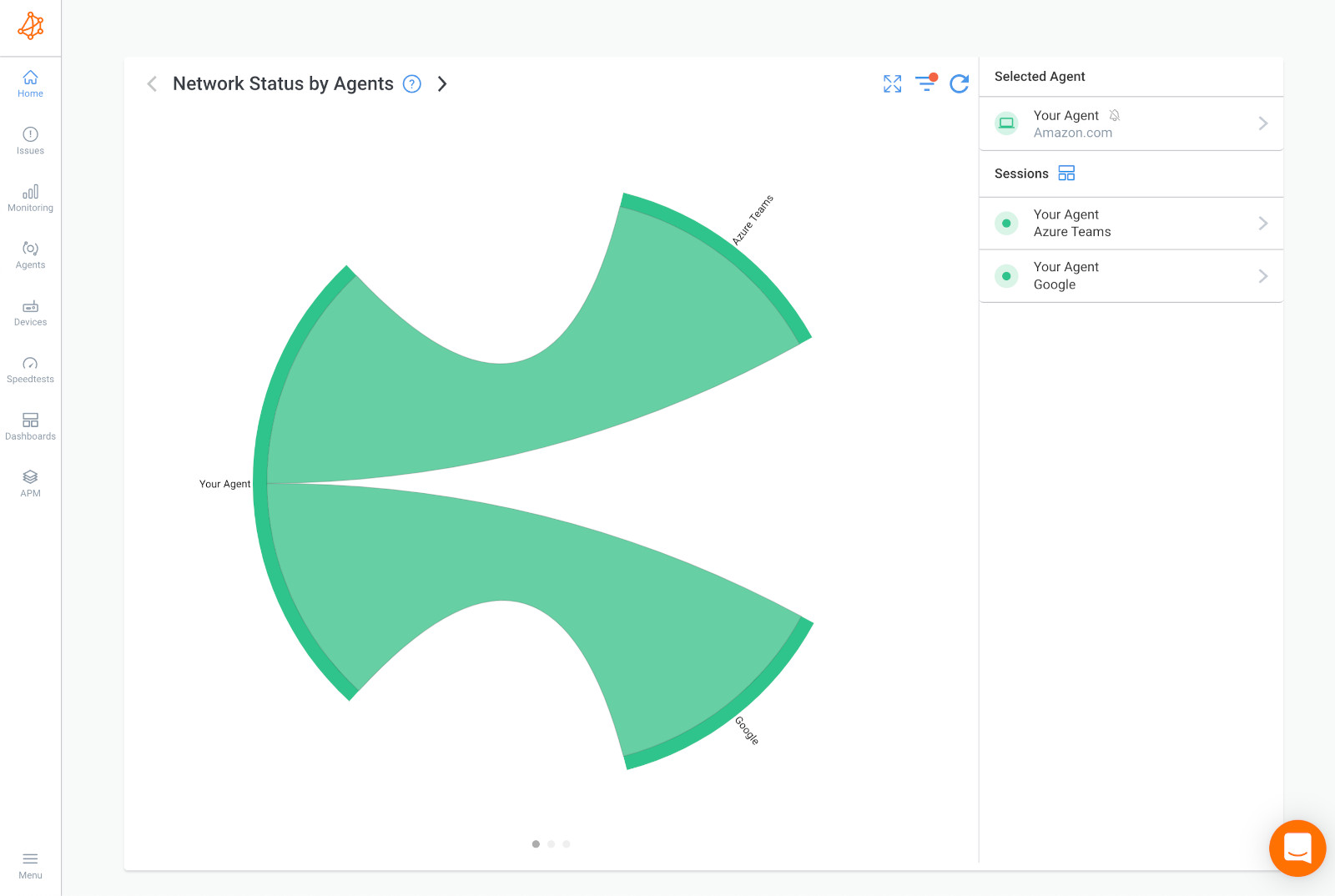
- Select key sites for Monitoring Agent placement to guarantee comprehensive coverage of network segments that require monitoring.
- Even for non-technical people, a seamless setup will be ensured by installing the Monitoring in the proper places.
- Monitoring Agents monitor several critical performance indicators, including latency, bandwidth consumption, and network traffic, once they are implemented.
- The collected data is meticulously examined by Obkio's advanced algorithms, which result in comprehensive performance reports and visualizations. These insights give you a clear view of the network's condition, enabling you to identify issues, allocate your resources as efficiently as possible, and make decisions with assurance.
- Precision from Monitoring Agents enables faultless service running by enabling timely discovery of performance issues for proactive issue solutions.
You have more duties as an ISP than just maintaining your own network, you also need to be able to see into the networks of your clients. Deploy Monitoring Agents across all client networks to ensure a proactive approach to improving performance and troubleshooting skills while navigating the intricacies of client networks.
80% of customer support calls to Internet providers are related to LAN and wireless issues. Stop customer support teams from blaming one another back and forth by utilizing Obkio to show that the network is not the problem, allowing customers to look into the issue independently without compromising your reputation as a service provider.
- Using Obkio's Monitoring Agents in conjunction with your clients' networks is a simple and effective approach to enhance network performance and prevent problems before they arise.
- Every client's network should have Monitoring Agents placed strategically, following your infrastructure's lead. These agents will monitor ISP network performance from your clients' networks, giving you visibility and understanding of the various aspects of their business operations.
- Priceless data regarding latency, packet loss, and other important network metrics pertaining to the functionality of client networks is gathered by the Monitoring Agents. Subsequently, this data is converted into comprehensive reports and visualizations that enable you and your clients to make informed decisions.
- Full network visibility from your clients' networks to your own allows you to locate the root of network issues. This collaborative troubleshooting strategy improves the relationship between you and your clients by removing the need for guesswork and speeding up the resolution of issues.
- Prompt Problem Solving: Monitor ISP performance from your client's perspective to promptly detect and fix issues, avert disruptions, and boost client satisfaction.
- Precise Troubleshooting: Determine the underlying cause of network problems for quicker solutions and more efficient use of resources.
- Client Endorsement: Provide clients with specific network knowledge so that they can work together to preserve top performance.
- Reliable Partner: You can establish yourself as a cutting-edge, forward-thinking partner by installing Monitoring Agents in your clients' networks.
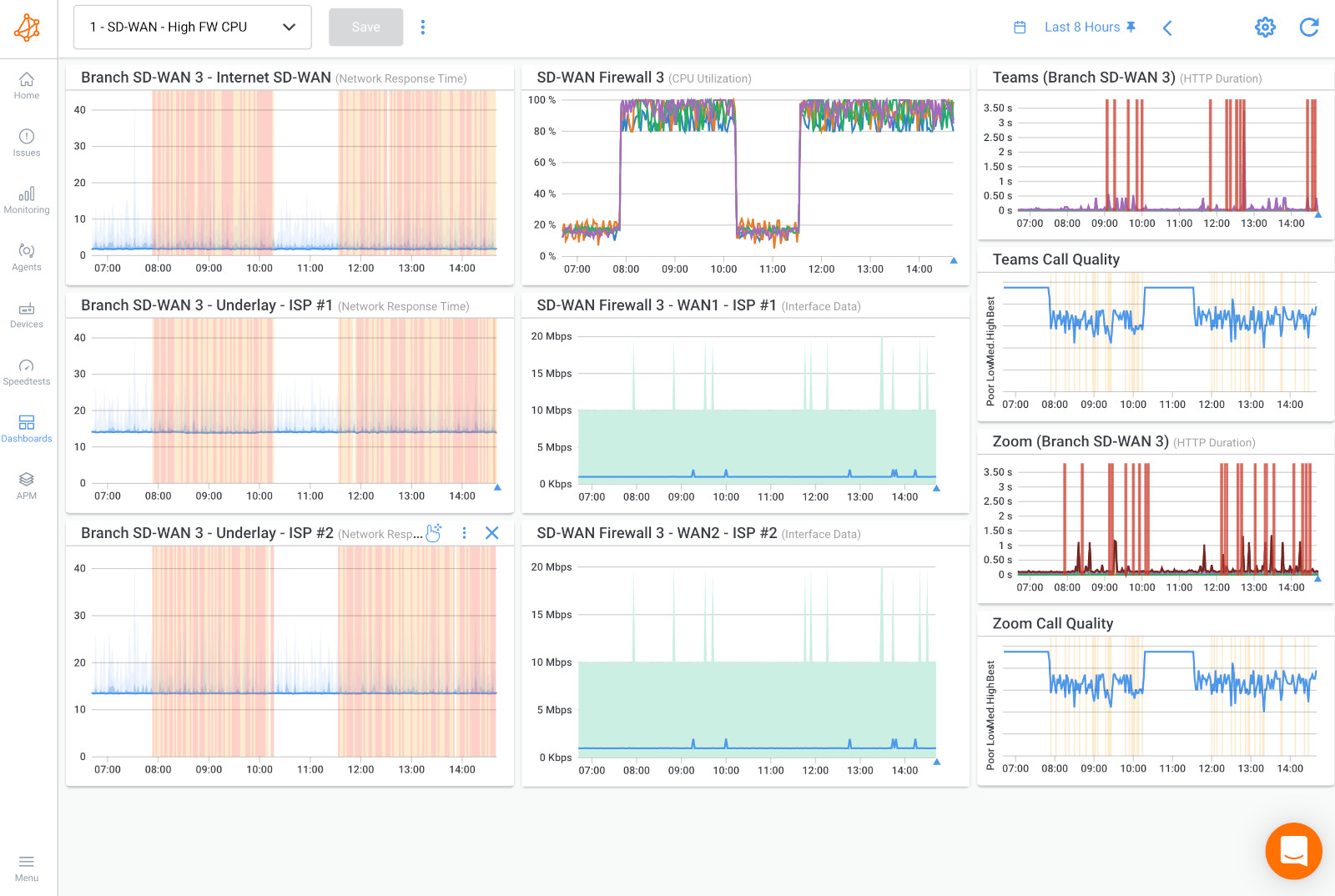
The process doesn't stop there, even though setting up Monitoring Agents on your network and the networks of your clients is an important initial step toward full network management. It becomes a continuous exchange with synthetic traffic that improves your capacity to maximize network performance across all systems.
- Synthetic monitoring offers a thorough understanding of network performance without interfering with real user activity.
- By proactive issue detection, a performance baseline is established, and alarms are set up to enable prompt issue identification and remediation.
- Collaborative troubleshooting not only promotes efficient problem-solving but also reduces blame.
- Synthetic traffic provides copious amounts of information that enable informed decisions on resource allocation, network upgrades, and enhancements.
- Understanding the network traffic patterns that take place between the networks of your clients and your own can help you make the best use of your resources.
By exchanging synthetic traffic continuously, Obkio's Network Monitoring solution gives ISPs the tools they need to manage network performance thoroughly and effectively.

Let's take a closer look at the key components that make up ISP networks and why you should be monitoring them!
1. Customer Connection:
- Subscriber Equipment: Customers connect to the ISP network using equipment provided to them, such as a modem or router.
- Access Technologies: The ISP utilizes various access technologies, such as DSL, cable, fibre-optic, or wireless, to establish a connection between the customer's premises and the ISP's network.
- Data Delivery to End Users: Finally, data reaches its destination, whether it's a website, an application, or another user on the Internet, completing the connection from the ISP to the end user.
Monitoring customer connections helps identify issues related to individual user experiences, such as connectivity problems, signal strength issues, or equipment malfunctions. Proactively identifying and troubleshooting customer connection issues contributes to overall customer satisfaction and a positive service experience.
2. Local ISP Network Infrastructure:
- Last-Mile Connection: The data travels through the "last mile," which refers to the connection between the customer's location and the nearest point in the ISP's network.
- Local Loop: In wired connections, like DSL or cable, data travels through a local loop of cables to reach the ISP's central office or headend.
Monitoring the local network infrastructure helps identify potential bottlenecks, signal degradation, or network outages in the last-mile connection. It allows ISPs to find and fix local network issues promptly, minimizing downtime and ensuring consistent service quality.
3. Central ISP Network Infrastructure:
- Central Office/Headend: At the central office or headend, the data from various local connections is aggregated and processed. This is where the ISP's core network begins.
- Routing and Switching: Routers and switches manage the flow of data within the ISP's network, determining the best paths for data to reach its destination.
Monitoring the central infrastructure is important for identifying and troubleshooting issues related to data aggregation, routing errors, or equipment failures in the central office or headend. This helps ISPs maintain network stability and prevents widespread service disruptions.
4. Core ISP Network:
- Backbone Infrastructure: The core network consists of high-capacity backbone connections, often using fibre-optic cables, that link different parts of the ISP's network together.
- Peering and Transit: The ISP connects with other ISPs through peering and transit agreements to exchange and route data across the broader Internet.
Continuously monitoring the core network helps identify congestion, routing anomalies, or equipment failures that may affect the overall performance of the ISP's backbone.
5. Internet Exchange Points (IXPs):
- Exchange of Traffic: ISPs often connect to Internet Exchange Points, where they can exchange traffic directly with other ISPs. This helps in more efficient and direct routing of data.
Monitoring traffic at IXPs helps ensure efficient and reliable data exchange between ISPs to identify potential congestion points and connectivity issues, therefore improving overall Internet connectivity for their customers.
6. Access to External Networks:
- Transit Providers: For data destined for locations outside the ISP's network, transit providers help carry the traffic to its final destination on the Internet.
- Content Delivery Networks (CDNs): Popular content is often cached in CDNs, and distributed globally to reduce latency and improve the speed of content delivery.
Monitoring transit providers and CDNs helps identify issues related to data transit, ensuring that traffic destined for external networks reaches its destination reliably. This can optimize external network connectivity, minimizing latency and improving the overall user experience.
Throughout this process, ISPs manage and optimize their networks to ensure a reliable and efficient Internet experience for their customers. The complexity of the ISP network is hidden from users, who simply enjoy the benefits of being connected to the vast world of online services and information.
Unleash the potential of your Internet Multihoming network with monitoring, troubleshooting & optimization tips. Master your network with Obkio's tool!
Learn more

In the game of connectivity, network monitoring for ISPs goes beyond the basics. It's about diving deep into those crucial network metrics that unveil the secrets of performance, reliability, and security.
Ready to decode the metrics that matter? Let’s dive in!
- Latency: It's the delay in data transmission between two points on a network. High latency? Think of slow response times.
- Packet Loss: Ever wonder about data packets that got lost on their way to the destination? Excessive packet loss means potential retransmissions and a hit on ISP network performance.
- Jitter: It measures variability in packet delay, which is crucial for smooth data transmission. Think about real-time applications – you want that consistency.
- Bandwidth Utilization: This tracks the amount of data transmitted versus network capacity. It helps spot congestion and plan upgrades.
- Network Traffic: Analyzing volume and patterns helps identify peak usage, bottlenecks, and trends affecting performance.
- Device Health: Keeping an eye on network devices ensures they're running smoothly. Use SNMP Monitoring or Network Device Monitoring, no surprises here.
- Application Performance: How are your applications doing? Tracking responsiveness and efficiency is key to a positive user experience and effective troubleshooting.
- Uptime and Downtime: These metrics measure network availability. They are important for reliability checks and areas of improvement.
- Response Time: Ever waited for a system or application to respond to your request? Slow response times impact user productivity.
- Throughput: This one measures the amount of data transmitted over the network in a given time. It's about capacity and performance.
- DNS Resolution Time: Monitoring this ensures efficient web browsing and application access. No one likes waiting for a page to load.
- CPU and Memory Usage: Keep an eye on resource utilization. It helps identify potential performance bottlenecks.
- Error Rates: Tracking error rates is like having a health check for your hardware. Identifying issues before they impact performance.
- Quality of Service (QoS): Ensures critical applications get the resources they need. Traffic prioritization at its finest.
- Network Topology Changes: Detecting alterations in network topology keeps things accurate and spots any unauthorized modifications.
These metrics empower ISPs with a holistic perspective on their network performance. By anticipating issues, optimizing resources, and ensuring top-notch service, ISPs can elevate the user experience for their clients.
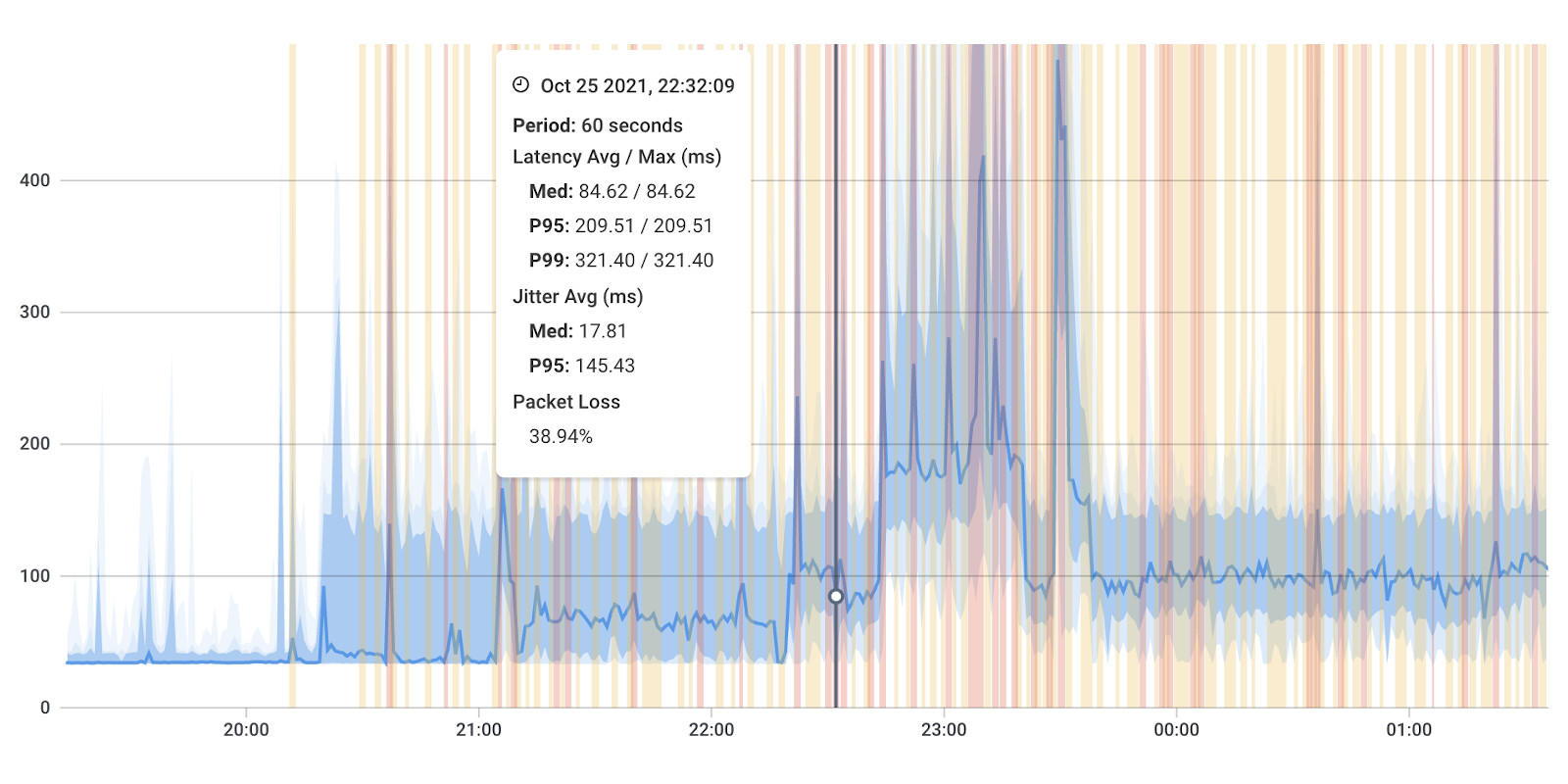
Ever had those network hiccups that just pop out of nowhere? Yep, we're talking about intermittent network problems. They're the annoying disruptions that show up randomly, making your network life a bit of a puzzle. Unlike the steady issues that are easy to point fingers at, these ones play hide-and-seek, making it a real challenge to figure out what's going on.
Picture this: your connection dropping out when you least expect it, data moving at the speed of a sloth, or your network ghosting you all together for a bit.
- Damaged or Loose Cables: Interference from badly connected, loose, or damaged network cables might cause problems with connectivity.
- Wireless Interference: Wi-Fi networks may experience sporadic outages due to radio frequency interference or signal obstruction.
- Hardware malfunctions: Network hardware including switches, routers, and network interface cards (NICs) can malfunction and cause sporadic network problems.
- Software Conflicts: Occasionally, network connectivity may be disrupted by software conflicts, out-of-date drivers, or firmware defects.
- Overheating: When network equipment overheats owing to insufficient cooling or inadequate ventilation, they may occasionally encounter problems.
- IP Address Conflicts: Devices with conflicting IP addresses may experience occasional connectivity issues.
- Log Analysis: Ever dug into network device logs? It's like reading the network's diary. Look for recurring error messages or patterns during those mysterious intermittent disruptions.
- Cable and Connection Checks: Time for some physical inspection. Ensure your network cables and connections are snug and free from battle scars.
- Device Testing: Test your network performance and devices under different conditions. Spot any intermittent hardware misbehaviour.
- Software Updates: Keep your network devices in tip-top shape. Ensure they're rocking the latest firmware, drivers, and software updates – it's the remedy for known bugs and compatibility hiccups.
- Environmental Assessment: Your network devices need a cozy environment. Check if they're cool enough and chilling in the right spots.
- IP Address Management: Implement IP address management practices to keep conflicts at bay and ensure a harmonious IP address assignment.
Learn the essential steps to troubleshoot network issues effectively. Start with Obkio's Network Performance Monitoring tool for comprehensive network insights.
Learn more

Bandwidth is the backstage manager handling the data shown within your ISP networks, measured in megabits per second (Mbps). So, higher bandwidth means your network can groove, transferring data faster and juggling a larger crew of connected devices – sounds like a party, right?
But here's the plot twist: Too much bandwidth can throw off the rhythm. Imagine your network as a dance floor, and suddenly, someone's hogging it, downloading gigabytes of data like there's no tomorrow. That's bandwidth congestion, causing a bottleneck and giving your ISP network a serious case of hiccups.
- Large Downloads: Picture this – hefty files making their way to your computer's hard drive, like massive transfers or backups. The bigger the file, the more it cranks up your bandwidth usage.
- Latency: It's the time a data packet takes to reach its destination. Consistent delays or bizarre spikes in delay time are red flags for major performance issues.
- Packet loss: When a data packet is dropped while travelling over a network, it never reaches its destination and returns. Depending on how much of the packet does not pass through and how frequently it happens, it might result in a significant amount of issues.
- Video streaming: One of the more frequent reasons for excessive bandwidth utilization is watching videos online. Up to 200 times more bandwidth may be required for 7k video streaming than for audio streaming.
- Large Applications: Some applications are high-maintenance. Those that demand an Internet connection – think web development programs, email, and gaming apps – are bandwidth guzzlers.
- File Sharing: Sharing is caring, but not always for your bandwidth. Programs that let users share files directly over the Internet can be heavy on your bandwidth, especially when dealing with hefty files.
- Legitimate Traffic: Activities like large file transfers, video conferencing, cloud backups, and software updates, though essential, can slurp up significant network resources, causing congestion during peak hours.
- Malware and Unauthorized Activities: Malicious software and unauthorized users can throw your bandwidth into chaos. Botnets, malware downloads, or sneaky file sharing can disrupt the bandwidth peace.
- Background Updates: Your devices have a secret life – automatic updates. Operating systems, applications, and antivirus software can silently use your bandwidth for updates without your say-so.
- P2P File Sharing: Peer-to-peer file-sharing programs can cause excessive bandwidth use since users can receive and upload files directly from one another.
- ISP Performance Monitoring: Picture Obkio as your trusty wingman. Use our ISP network monitoring software to measure and track bandwidth usage in real-time. Keep an eye on usage patterns, and be on the lookout for any unexpected spikes or persistently high traffic.
- Application Analysis: Dive into the bandwidth consumption of different applications to uncover the resource-hungry culprits. Identify which apps are the main contributors to the bandwidth feast.
- Quality of Service Policies: Introduce QoS policies to give VIP treatment to critical applications and services. This way, even during peak hours, the essential operations get the bandwidth red carpet.
- Bandwidth Optimization: Time to trim the excess. Deploy bandwidth optimization techniques like compression, caching, or content filtering to cut down on data transfer. Streamline your bandwidth usage for a more efficient network.
- Traffic Shaping: Implement traffic shaping mechanisms to manage and restrict bandwidth usage for specific applications or users. It's like having traffic signals for your network.
- Identify Malware or Unauthorized Activity: Regularly scan for malware and unauthorized guests in your network. Put up strong security measures to prevent any attempts at exploitation.
Wireless networks, including our beloved Wi-Fi, dance to the beat of radio frequencies to transmit data between devices. But when unwanted guests (other devices or signals) crash the party, the result is a chaotic communication breakdown, leading to sluggish or unreliable connections.
Identifying and neutralizing these troublemakers is key to preserving the peace in your wireless kingdom.
How do you know interference is casting its dark shadow?


- Channel Overlap: Multiple Wi-Fi networks coexist in the same space, but their channels overlap, leading to a chaotic clash of signals. The result? Interference that disrupts the harmonious flow of your Wi-Fi connection.
- Obstacles on the Path: Walls, floors, and substantial objects – these are more than just the physical features of your living space. In the world of Wi-Fi, they transform into interference agents, compromising signals and diminishing their strength.
- Electronic Gadgets: Interference can be produced by other electronic devices that use comparable frequencies, such as microwaves, Bluetooth devices, and phones.
- Access Point Arm Wrestle: Imagine a scenario where multiple access points stand shoulder to shoulder, fighting for attention. In this crowded space, their signals might clash, creating interference turbulence. This is especially true if these access points share the same channels or overlap in frequency domains.
- Signal Refraction and Reflection: Dead zones and signal interference can result from Wi-Fi signals reflecting off objects or refracting through materials.s, and let your Wi-Fi connection shine without disruption.
- Physical Obstacles: Determine which physical obstacles such as walls, furniture, metal items, or heavy appliances may hinder or weaken the Wi-Fi signal. Then, remove or rearrange them.
- Neighbouring Wi-Fi Networks: To find neighbouring Wi-Fi networks and the channels they use, use a Wi-Fi analyzer tool. To lessen interference, use a wireless network channel that is less crowded.
- Wireless Phones and Microwaves: Both operate in the same 2.4 GHz frequency range as Wi-Fi networks. To reduce interference, keep Wi-Fi access points away from these gadgets.
- Bluetooth Devices: Particularly in the 2.4 GHz frequency range, Bluetooth devices have the potential to interfere with Wi-Fi networks. Wi-Fi channels that are distant from Bluetooth frequencies should be used, or Bluetooth devices should be kept apart from Wi-Fi access points.
- Electronics: Find and move any electronic equipment that emits radio-frequency interference (RFI) or electromagnetic interference (EMI), such as wireless speakers, cameras, or baby monitors.
- Dual-Band Wi-Fi Devices: Use devices that are capable of operating in both the 2.4 GHz and 5 GHz frequency bands, if at all possible. Better performance and often less congestion can be seen in the 5 GHz frequency.
- Wi-Fi Signal Strength: To find places with weak signals that can be vulnerable to interference, measure the Wi-Fi signal strength at several sites throughout the coverage area.
- Wi-Fi Access Point Placement: To improve coverage and lessen dead zones, strategically deploy Wi-Fi access points. For larger areas, think about utilizing mesh networks or Wi-Fi range extenders.
- Wi-Fi Signal Overlapping: To prevent interference, keep your Wi-Fi signal coverage from numerous access points overlapping. To reduce overlap, change the channel or transmit power settings on the access point.
- Rogue Wi-Fi Devices: Search for any devices or rogue Wi-Fi access points that may be causing network interference. Unauthorized devices can be identified by using wireless intrusion detection systems, or WIDS.
- DFS Channels (5 GHz): Because of requirements for radar detection, certain channels in the 5 GHz band need to use Dynamic Frequency Selection (DFS). Make sure the DFS channels you're utilizing on your devices are compatible with DFS.
- WLAN Enhancement: Employ band steering and airtime fairness as Wi-Fi optimization strategies to balance client connections and minimize interference.
- Wireless Site Survey: Conduct it in order to evaluate the general state of the wireless environment and locate any possible interference sources.
- Quality of Service (QoS): Use QoS rules to reduce the effect of non-essential traffic on network performance and to provide priority to important Wi-Fi traffic.
- Frequent Monitoring: To identify and proactively resolve problems, keep an eye on client connectivity, Wi-Fi performance, and interference levels.
- Updates to the Firmware: Update the firmware on your wireless devices and Wi-Fi access points to benefit from bug fixes and performance enhancements.
The challenges mentioned above are just the tip of the iceberg. If you're eager to equip yourself with a comprehensive understanding of these hurdles and learn effective strategies to tackle them, delve into our in-depth article on the 16 Most Common Network Problems: How to Find & Fix Them.
It's a valuable resource that goes beyond the surface, providing insights and solutions to ensure top-notch ISP performance monitoring.
After discussing the foundational elements of ISP performance monitoring, let's move on to real-world examples.
Entire Client Visibility
Consider being able to see every corner of your client's network from above. This vision comes to pass with ISP Network Monitoring software. It's about obtaining total visibility, which includes identifying possible bottlenecks and comprehending network traffic patterns. Ensuring optimal network performance is more important than merely keeping an eye on the network's uptime.
Active Problem-Solving
The capacity of ISP performance monitoring to identify problems before they become serious ones is what makes it so beautiful. It resembles giving your network a superhero cape. Proactive troubleshooting becomes your standard procedure by looking for abnormalities, monitoring performance indicators, and anticipating possible problems.
Instead of calling for firefighters, let's put out fires in their earliest stages.

With Obkio you can say goodbye to firefighting and address issues at their inception.

Proactive Customer Service
Reactive answers are only one aspect of supporting clients. Monitor ISP performance so that you're proactive rather than passively waiting for clients to bring up problems. Client assistance is transformed from a service to an experience through proactive activities such as anticipating needs, addressing issues, and guaranteeing a flawless network experience.
Following Internet SLAs
Service obligations are anchored by Service Level Agreements (SLAs). For Internet providers, network monitoring transforms service-level agreements into a dynamic reality. You can be sure that network performance meets or surpasses expectations by regularly comparing it to predetermined benchmarks. It's revolutionary and solidifies your standing as a trustworthy supplier in the online world.
In conclusion, this article has provided valuable insights into the crucial aspects of monitoring ISP networks, empowering network admins and business owners with the knowledge to navigate the complexities of ISP network management. However, understanding alone can only take you so far. It's time to transition from discussions to proactive measures.
Don't wait for network issues to disrupt your operations, start now with Obkio. With the ability to troubleshoot with pinpoint accuracy and swiftly resolve issues, Obkio minimizes downtime and elevates the standard of ISP network monitoring to new heights.
- 14-day free trial of all premium features
- Deploy in just 10 minutes
- Monitor performance in all key network locations
- Measure real-time network metrics
- Identify and troubleshoot live network problems



























 Obkio Blog
Obkio Blog






